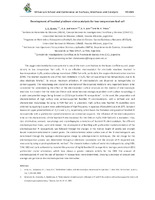Development of facetted platinum eletrocatalysts for low temperature fuel cell
Date
2018-08-10Author
Ramos, Silvina Gabriela
Andreasen, Gustavo Alfredo
Ares, Alicia Esther
Triaca, Walter Enrique
San Luis School and Conference on Surfaces, Interfaces and Catalysis (6º : 1 a 8 de junio 2018 : Santa Fe)
Metadata
Show full item recordAbstract
The oxygen electroreduction overpotential is one of the main contributions to the losses in efficiency and power density in low temperature fuel cells. Pt is an effective electrocatalyst for electrodic reactions involved in low-temperature H2/O2 proton exchange membrane (PEM) fuel cells, particularly the oxygen electroreduction reaction (ORR). This reaction represents one of the main limitations in H2/O2 fuel cell operating at low temperatures, due to its slow electrode kinetics1. To ensure maximum utilization, Pt electrocatalysts are dispersed as nanoparticles on carbon-supports. The morphology and crystalline orientation of the dispersed metal are very important factors to be considered for understanding the effect of the electrocatalyst surface structure on the kinetics of electrocatalytic reactions. It is known that the molecular ORR in acid media becomes strongly dependent on Pt surface morphology in a wide overpotential range, being favored on (111)-type facetted Pt nanoparticles1. In this work, the preparation and characterization of high surface area carbon- supported facetted Pt electrocatalysts, with a defined and well characterized morphology for using in PEM fuel cell, is presented. High surface area facetted Pt crystallites were obtained by applying a square wave potential pulse of high frequency in aqueous chloroplatinic acid at 25°C, between lower and upper potential limits of -0,2 V and 1,2 V, respectively, which favors the formation and growth of facetted Pt nanoparticles with a preferential crystal orientation on conductive supports. The influence of the electrodeposition
time on the characteristics of the facetted Pt electrocatalyst for the ORR on H2/O2 PEM fuel cells is evaluated. Thus, size, distribution, amount, morphology and crystallographic orientation of facetted Pt electrocatalysts, for different
electrodeposition times, were determined. The development of facetting with preferential crystal orientation of the electrodeposited Pt nanoparticles was followed through the changes in the relative height of weakly and strongly
bound H-adatom voltammetric current peaks. The electrochemical active surface area of the Pt electrodeposits was determined through the hydrogen electrosorption charge by voltamperometric techniques. The net charge for the electrodeposition process was determined through an electronic coulometer and the amount of Pt deposited was measured by using a spectrophotometric method2. The characterization studies of metal electrodeposits by using SEM, TEM, XRD and cyclic voltammetry revealed the presence of highly facetted Pt nanoparticles having a predominant (111) preferential crystal orientation, which have shown a greater catalytic activity for the ORR. The amount of electrodeposited Pt and the size of facetted Pt nanoparticles were determined, showing a decrease of amount and average size particle as the electrodeposition time diminishes.
Collections
The following license files are associated with this item:



